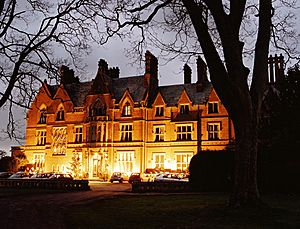Christopher Wren the Younger facts for kids
Christopher Wren (born 1675, died 1747) was an important person in British history. He was the son of the very famous architect Sir Christopher Wren, who designed St Paul's Cathedral. The younger Christopher Wren was a Member of Parliament, which means he helped make laws for the country. He also worked closely with his father on big building projects.
Contents
About Christopher Wren
Early Life and Education
Christopher Wren was the second son of Sir Christopher Wren and his first wife, Faith Coghill. He was the first of their sons to survive past childhood. He went to school at Eton and then studied at Pembroke College, Cambridge. His father had actually designed the new chapel at Pembroke College, which was one of his first completed buildings.
Christopher started at the college in 1691 but left without finishing his degree. In 1693, he became a member of the Royal Society, which is a group for important scientists and thinkers. He also joined the Middle Temple in 1694, which is a place where people train to become lawyers.
Travels and Work
Around 1698, Christopher traveled around Europe. He visited France, Italy, and Holland to study architecture. He went with Edward Strong the Younger, whose father was a main builder for Sir Christopher Wren. This trip showed they had a good friendship, not just a work connection.
When he returned, Christopher started working for his father as a clerk-of-works. This job meant he helped manage building projects. He became the Chief Clerk of Works in 1702 and held that position until 1716. In 1708, he had a special moment: he placed the very last stone on the dome of St Paul's Cathedral. His famous father was there to see it! In 1711, he was chosen to help organize the building of 50 new churches.
A Member of Parliament
Christopher Wren also served in the British Parliament. He represented the area of Windsor from 1713 to 1715. He was re-elected in 1715, but he later lost his seat after a special review. He also lost his job as Chief Clerk of Works in 1716. After this, he decided to live a quieter life as a country gentleman. He moved to the Wroxall Abbey estate in Warwickshire, which his father had bought in 1713.
Later Life and Hobbies
Christopher Wren spent time collecting important papers about his father's life. These papers were later published after Christopher's own death by his son, Stephen, in a book called Parentalia in 1750. A picture of Christopher, made by Faber, is at the very front of this book.
Letters written by Sir Christopher to his son when he was young show that they had a loving relationship. Christopher was also known for his interest in old coins, a hobby called numismatics. He even published a book about ancient coins in 1708 called Numismatum Antiquorum Sylloge.
Family
Christopher Wren passed away in London on August 24, 1747. He was married twice. His first wife was Mary Musard. His second wife was Constance Middleton, who passed away in 1734. He had two sons who survived him: Christopher (born 1710), who inherited Wroxall Abbey, and Stephen (born 1722).
| Parliament of Great Britain (1707–1800) | ||
|---|---|---|
| Preceded by Charles Aldworth |
Member of Parliament for New Windsor 1713–1715 With: Charles Aldworth Robert Gayer |
Succeeded by Sir Henry Ashurst, Bt |
![]() This article incorporates text from a publication now in the public domain: "Wren, Christopher (1632-1723)". Dictionary of National Biography. (1885–1900). London: Smith, Elder & Co.
This article incorporates text from a publication now in the public domain: "Wren, Christopher (1632-1723)". Dictionary of National Biography. (1885–1900). London: Smith, Elder & Co.


